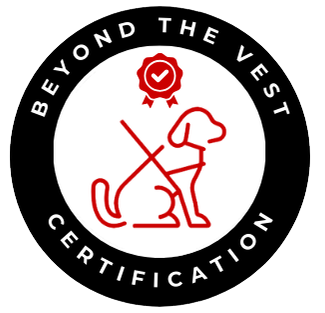|
At Beyond the Vest Certification, we set the bar for what a true service dog should be - reliable, professional, and prepared for any public setting.
In the absence of universally recognized government regulations for service dogs, we’ve taken it upon ourselves to establish the standards that ensure each dog we certify is fully equipped to support their handler - confidently and responsibly - in any public setting. Here's what we expect from every service dog we certify:Handler Responsiveness and Control
The handler should be able to control the dog effectively, responding quickly to any signs of agitation or distraction at all times. Focused Attention on Handler The dog should remain focused on the handler, ignoring people and other animals unless directed to interact. Controlled Leash Behavior The dog should walk calmly beside the handler on a loose leash without pulling, straining, or lagging behind. The dog must adjust its speed to match the handler’s pace, whether walking in a straight line or making turns. Non-Aggressive and Friendly Demeanor The dog must show no aggression toward people or animals, remaining calm in all public interactions. Calm Greeting Manners The dog should greet people without jumping or showing excessive excitement. Noise and Distraction Resilience The dog should display calmness in response to loud noises, sudden movements, or unfamiliar people. Ability to Navigate Crowded Spaces The dog should be able to move calmly through crowds without reacting to close proximity or sudden movements. Tolerance of Physical Contact The dog should remain calm if accidentally bumped or touched by a passerby. Separation Tolerance The dog should stay calm if briefly separated from the handler. Responsive Bark Control The dog must refrain from excessive barking and should stop barking on command. Impulse Control Around Food The dog should ignore food on the ground or within reach unless directed to engage. Settling in Public Spaces The dog should lie down or sit calmly in public, focusing primarily on the handler. Extended Place or Stay Ability The dog should hold a “place” or “stay” position for up to one hour when needed. Elimination on Command The dog should relieve itself on command in appropriate outdoor areas only. Extended Quiet Times The dog should be able to remain quiet and settled for extended periods, even during long wait times. Ability to Follow Commands in Varied Environments The dog should reliably follow commands in new and unfamiliar environments with varying surfaces, lighting, and smells. Moderate Food/Treat Focus The dog should not be overly reliant on treats or food rewards for good behaviour. Health and Grooming Standards The dog must be clean, well-groomed, up-to-date on vaccinations, and preferably spayed or neutered. Emergency Preparedness The dog should respond calmly to commands like “quiet” or “settle” in unexpected, high-stress situations. Sensitivity to Individuals with Mobility Aids or Accessibility Needs The dog should remain calm around people using wheelchairs, canes, or other mobility aids. Our standards define what it means to be a responsible handler with a well-trained and tested service dog - one that exemplifies unwavering support, professionalism, and the trust that forms the foundation of every successful service dog team.
|
© 2024 Beyond The Vest Certification. All Rights Reserved.
Privacy Policy | Terms of Service | Terms of Use
Privacy Policy | Terms of Service | Terms of Use

